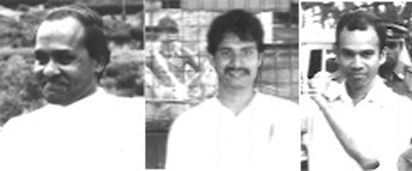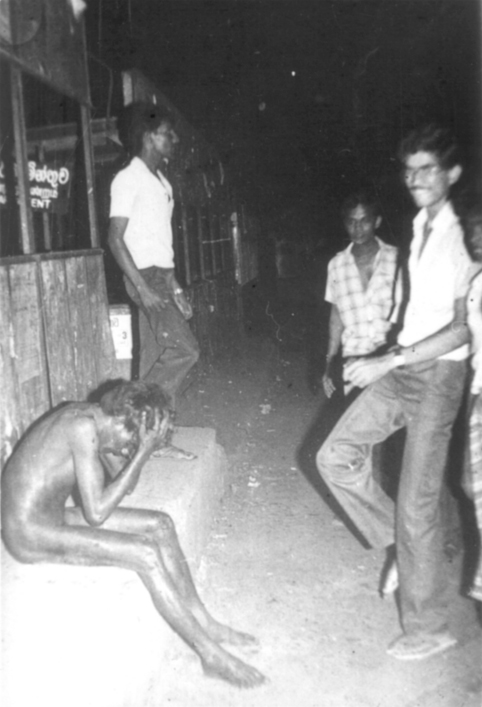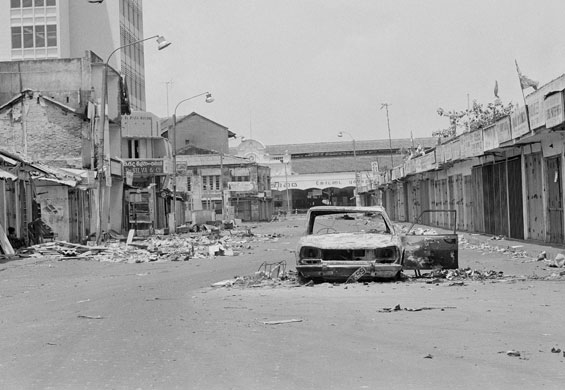Sinhala rioters celebrate as they pause in the destruction of homes and businesses in Tamil sectors of Colombo
Today marks thirty-seven years since the horrors of the anti-Tamil pogrom of 1983, when thousands of Tamils were killed by Sinhala mobs backed by the then UNP government and state forces.

Sinhala rioters halt a minibus searching for Tamils
Armed with electoral rolls, Sinhala mobs targeted Tamil homes and businesses, looting and ransacking property. Driven from their homes, particularly in Colombo, over 3000 Tamils were massacred, whilst thousands more were effectively deported by the state to the North-East.
Eye witness reports described mobs chasing Tamils down the street with knives and setting them alight alive. Hundreds of women were raped. Tamil political prisoners locked up in Welikada jail, deep within the island's south, were also targeted as prison guards allowed Sinhala inmates to slaughter them.
A look back
We look back at events through international press coverage at the time:
21 Jul 1983 - The Times:
"The Government yesterday imposed local and foreign press censorship on all news about national security, law and order, essential supplies, and incitement to mutiny, riot or civil commotion."
23 Jul 1983 - The Montreal Gazette
"The officials said 17 prisoners died in a jailbreak at the Welikada jail in the capital of Colombo, where 35 Hindu Tamil prisoners were massacred Monday by fellow inmates belonging to the nation's Buddhist Sinhalese majority. Guards also opened fire yesterday on rioting Tamil prisoners in the jail of Jaffna, 386 kilometres north of Colombo killing three of them"
26 Jul 1983 - The Daily Telegraph:
“Motorists were dragged from their cars to be stoned and beaten with sticks. Others were cut down with knives and axes. Mobs of Sinhala youth rampaged through the streets, ransacking homes, shops and offices, looting them and setting them ablaze, as they sought out members of the Tamil ethnic minority. A mob attacked a Tamil cyclist riding near Colombo’s eye hospital. The cyclist was hauled from his bike, drenched with petrol and set alight. As he ran screaming down the street, the mob set on him again and hacked him down with jungle knives.”
27 Jul 1983 - The Times:
"Here in Britain some of the 25,000 Sri Lanka Tamils blamed the start of the fighting on an incident last week in which three teenage girls at a bus-stop near Jaffna in the north of Sri Lanka were allegedly abducted and raped by soldiers. On girl was later said to have committed suicide.
They also claim another atrocity in which six schoolboys were shot and killed by troops and police in the same area. They blame these incidents for prompting the attack by Tamil guerrillas on a Sri Lankan Army vehicle on Saturday, in which 13 soldiers were killed."
27 Jul 1983 - The Times :
"These mostly involved in the present troubles are the Ceylon Tamils, a highly educated, superior minority, who feel victimized by the Sinhalese. Not only are there fewer industrial opportunities for them in the north but Tamil boys have been discriminated against in winning places at university"
"Despite their minority status the Tamils for years held top jobs in business and administration under the British, jobs they have mostly since lost under Sinhalese rule. The cause of the present violence must therefore be seen in part economic terms"
28 Jul 1983 - The Times :
"Smoke from hundreds of shops, offices, warehouses and homes blew idly over Colombo yesterday. Any business, any house belonging to, or occupied by a Tamil has been attacked by gangs of goondas (hooligans) and the resulting destruction looks like London after a heavy night's attention from the Luftwaffe."
"Government officials yesterday estimated that 20,000 business had been attacked in the city and declared that there was a pattern of organisation and planning in the rioting and looting."
"One of the principal reasons for Britain's delay in granting independence to its former colony was because of fears that the majority would tyrannize the minority Tamils. But the majority Sinhala speakers feel that they are threatened by 40 million Tamil speakers in India."
29 Jul 1983 - The Montreal Gazette :
"Addressing the island nation on radio and television for the first time since violent clashes between majority Sinhalese and minority Tamil erupted six days ago, Jayewardene said the Tamil movement "should have been banned long, long ago. The Sinhalese will never agree to the separation of a country that has been a united nation for 2500 years," Jayewardene said.
People who advocate separatism the president said, would lose all their "civic rights", be banned from holding any office and preventing from practising a profession."
A government official also confirmed that 130 Sinhalese sailors of the Sri Lankan navy broke from their barracks in the port city of Trincomalee Monday and burned 175 houses in a Tamil neighbourhood, killing one Tamil and wounding 10 others.
A Norwegian tourist reported seeing a Sinhalese mob pour gasoline on a minibus full of about 20 Tamils in Colombo and set it on fire. From Oslo, Eli Skarstein was quoted as saying, "Colombo was burning when we left. Women, children and old people were slaughtered. Police and soldiers did nothing to stop this genocide."
Douglas Liyanage, secretary of the ministry of state, acknowledged that Sinhalese passengers on a Colombo-bound train from the central Sri Lanka town of Kandy had attacked Tamil passengers they suspected of carrying weapons. Passengers said one of the Tamils was chased naked and bleeding through the railway cars until he fell dead and was thrown off.
The wave of killings was touched off by the ambush and slaying of 13 Sinhalese soldiers by Tamil insurgent guerillas over the weekend. But the violence grows out of a century of deeply-rooted hatred, along with differences of language and religion between the Buddhist Sinhalese and the Hindu Tamils."

29 Jul 1983 - The Times :
"Political parties advocating the partition of Sri Lanka will be banned, President J R Jayawardene announced yesterday as news emerged of a second massacre in Colombo's main jail.
In an attempt to appease the mobs which have attacked Tamil homes and businesses, the President declared that those seeking partition will "lose their civil rights and cannot hold office, cannot practise professions, join movements of organizations".
Mr Jayewardene said in a nationwide broadcast: "The government has not decided that the time has come to accede to the clamour and the request, the natural request, of the Sinhala people that we do not allow the movement for division to grow any more."
29 Jul 1983 - The Age :
"Frustrated expectations of increased self-rule for the Tamil community, coupled with Government fears that its support from the majority Sinhalese was slipping, appear to have been the primary combustibles that ignited the worst violence in this scenic island nation since 1948."
01 Aug 1983 - The Sydney Morning Herald :
"The Sri Lankan Government has cracked down on political opponents and appealed for public support, saying ethnic bloodshed on the island is part of a foreign-inspired plot to overthrow it."
04 Aug 1983 - The Times:
“Sri Lanka Army personnel actively encouraged arson and the looting of Tamil business establishments and homes in Colombo. … Absolutely no action was taken to apprehend or prevent the criminal elements involved in these activities. In many instances army personnel participated in the looting of shops.”
Welikada prison massacre

Tamil political prisoners: Dr S Rajasunderam, Selvarajah Yogandram and Nadarajah Thangathurai
On the 25th July 1983 Sellarasa “Kuttimani” Yogachandiran, leader of the Tamil Eelam Liberation Organisation (TELO) and Ganeshanathan Jeganathan, a political writer, had their eyes gouged out in mockery before being killed by Sinhalese inmates at the high security Welikada prison in Colombo. A total of 37 Tamil prisoners were murdered the same day, and 18 more were killed two days later.
5th August 1983 – The Guardian
"It is the massacres in the Welikade gaol which are attracting the most attention. There is a particular interest in circumstances in which two alleged guerrilla leaders were killed.
The two men, Sellarasa “Kuttimani” Yogachandiran, leader of the Tamil Eelam Liberation Organization (TELO) and a political writer, and Ganeshanathan Jeganathan had been sentenced to death last year for the murder of a policeman.
In speeches from the dock, the two men had announced that they would donate their eyes in the hope that they would be grafted on to Tamils who would see the birth of Eelam, the independent state they were fighting for.
Second hand reports from Batticaloa gaol, where the survivors of the Welikada massacre are now being kept, say that the two men were forced to kneel and their eyes gouged out with iron bars before they were killed.
Read more on the massacre here.
Testimonies

"From the back seat of uncle Gratien’s car, I saw Tamils dragged out of buses and killed. I saw shops being looted and burnt. I clutched Arju’s leg really tightly and fought back all emotion. We couldn’t draw any attention to ourselves. The rioters were looking for Tamils in cars, buses, shops, homes."
See one individual’s story here, documented by Tamil Survival Stories here.
"30 years ago this day my dad was dragged out of his car in the heart of Colombo whilst a government-incited mob baying for Tamil blood attempted to pour kerosene on him and set him alight."
Selvan Ratnarajah*
"30 years ago people who spoke my mother tongue, shared my ethnicity, my culture, my skin colour and history, people who carried names like mine, ID cards like my father’s, pottus like my mother’s, started to embark on a journey of forced displacements and migrations following the apocalyptic violence of July 23. Northbound at first, in direction of their occupied homeland, they ran for their lives before bombings and assassinations struck home and made them run and swim east and westbound. Safety was seldom, sanctuaries compromised."
Sinthujan Varatharajah
Read more restimonites in our feature: Memories beneath the surface.. #BlackJuly 1983
'Naked and bloodied'

'Naked and bloodied, the exhausted youth slumps on a bench by the filthy roadside, his head in hands, awaiting the final blows.
His casually dressed pursuers gather round. One be-spectacled young man grins as he raises his right knee in preparation for another blow.
This single image, above all others, has come to represent the traumatic events of ‘Black July’ 1983 for Sri Lanka’s Tamils.
Find out more about this iconic photograph here.
A history of violence
Black July was not the first time Tamils had been targeted and killed by rampaging Sinhala mobs. In 1956, over 150 Tamils were killed in the Eastern Province. Two years later, in 1958, widespread riots left over 300 dead. In 1977, less than a month after the UNP came to power, anti-Tamil riots left another 300 dead. In 1981, anti-Tamil riots took place, with ruling party MPs supervising the violence in Jaffna.

For more on the events that led up to Black July, see our previous feature, 'Anatomy of a pogrom'. Extract produced below:
"Contrary to popular belief, the July 1983 anti-Tamil pogrom, sometimes referred to as their Holocaust, was not a spontaneous reaction to the ambush of a Sri Lankan army patrol by Tamil guerrillas. In a report on the attacks, the International Commission of Jurists said “the suspicion is strong that this organised attack on the Tamil population was planned and controlled by extremist elements in the government UNP party, and that the killing of the 13 soldiers by [Tamil guerrillas] served as the occasion for putting the plan into operation. The reports go so far as to allege that a member of the Cabinet was actively involved in planning these attacks."

Also see this piece, Beneath the Ashes: Remembering Black July and the Violence Before, by Brannavy Jeyasundaram. Extract reproduced below:
The Black July pogrom carried all the hallmarks of genocide: most notably, mobs were armed with voter registration lists distinguishing Tamils as targets of violence. In this nightmarish rampage against the Tamil people, it is unsurprising that the motivations behind such horror have been reduced into a cause-and-effect narrative. Many of us are familiar with this version: the LTTE killed 13 Sri Lankan soldiers, the next day Sinhala mobs ran amok, supposedly in an outburst of rage in response to the Sinhala deaths. The underserved truth, however, is that the pogrom began before the Tigers’ attack reached public consciousness.
The events preceding the pogroms make it abundantly clear that Black July was not a spontaneous spur of violence against Tamils — it was premeditated. It was a genocide rooted in increasingly hostile and violent conditions restricting Tamil life and survival. The following is an account of the months leading to Black July and the state’s deliberate commission or permissiveness of anti-Tamil violence on the island. It is important to note these accounts are not an exhaustive list of events but an attempt to illustrate the pervasiveness of steadily increasing state violence against Tamils.
What Black July means for the future
"While Black July destroyed the Tamil economic base in the island, it created the now flourishing global Diasporic economic base. While it sought to silence Tamil political struggle ‘for once and for all’, it instead spread Tamil activism across the world. It sought to erase the Eelam Tamil cultural symbolism and identity, but instead rendered them globally recognised.
The present is thus inextricably linked to the past. And the past will also define the future. Until there is accountability for the mass atrocities against the Tamil people, until justice – the bedrock for any lasting peace - emerges, until Tamils are recognised as a people with equal rights and a rightful place in their homeland, the island’s northeast, Sri Lanka will remain synonymous with ethnic strife."
- Jan Janayagam, 2011, London. See her comment here.
